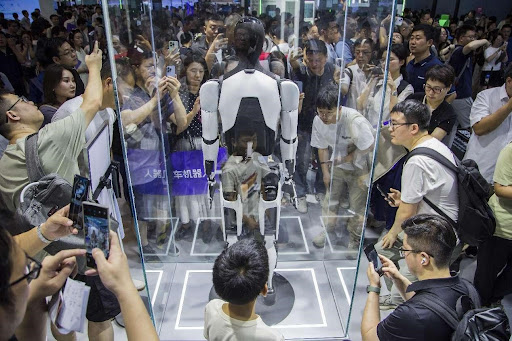By Xie Weiqun, Shen Wenmin, People’s Daily
The 2024 World AI Conference (WAIC) and High-Level Meeting on Global AI Governance was held in Shanghai from July 4 to 6, featuring 107 forums, more than 1,500 exhibitions and over 50 launch events.
With an exhibition area of more than 52,000 square meters, the conference featured a “full-domain connection hall” of 6000 square meters for project incubations, procurements and investment matchmaking. Nearly 100 large models were exhibited, and China’s first full-sized general-purpose humanoid robot prototype was also launched at the conference.
The AI exhibition held during the conference attracted more than 500 renowned enterprises. At the exhibition, visitors were amazed by how new technologies are transforming industries across the board. For instance, a large model developed by Chinese AI software provider SenseTime can bring photos to life, animating figures’ expressions and movements in photos to create dynamic videos. Besides, Alipay’s smart assistant can quickly answer questions and handle tasks with the command of users.
Among the exhibits, there were not just large language model application products but technical and service products supporting their operations.
INTSIG Information Co. Ltd., an industry-leading tech company specializing in business data, AI, and mobile applications, has launched a large model accelerator that can speed up pre-training, corpus development, practical implementation and other processes for large model applications. This accelerator can quickly parse unstructured data from lengthy documents of hundreds of pages and intelligently reconstruct the correct reading order of documents.
The conference also featured a dedicated demonstration zone for humanoid robots, showcasing more humanoid robots than ever before. For instance, at the exhibition booth of Robot Era, a robot developer in Beijing, a large screen displaying a humanoid robot climbing the Great Wall attracted huge attention. Besides, the “Healthy Loong” humanoid robot developed in Zhangjiang High-tech Park, Shanghai, announced its open-source status, aiming to advance towards general AI. These novel and impressive humanoid robots made visitors feel as if they were stepping into the future world.
According to statistics, the conference received over 300,000 in-person visits and 2 billion online views, an increase of 90 percent from the previous session, setting new records.
The advancement of AI technology, while driving economic and social development, has brought risks and challenges, including deepfakes, privacy breaches, and intellectual property disputes.
Andrew Chi-Chih Yao, a Turing Award winner and academician of the Chinese Academy of Sciences, believes that the risks of AI manifest in the extension and expansion of cybersecurity threats, as well as in unforeseen social risks.
Strengthening global AI governance urgently requires building consensus through dialogue and cooperation. The Shanghai Declaration on Global AI Governance, issued at the conference’s opening ceremony, presents China’s proposals for global AI governance.
This year’s WAIC featured the first High-Level Meeting on Global AI Governance. Over three days, a total of 1,300 guests from more than 50 countries and regions participated in thematic discussions.
Xue Lan, dean of Schwarzman College and head of the Institute for AI International Governance of Tsinghua University, said that to promote global AI governance, it is important to strengthen collaborative governance, expand multi-level and multi-channel bilateral and multilateral exchanges and dialogues, and advance international AI big science cooperation to jointly address the risks and challenges brought by AI technology.
This conference featured 107 forums, focusing on topics such as model algorithms and computing power, embodied intelligence, and industrial ecology.
When discussing the future development of large models, Zhang Yaqin, dean of the Institute of AI Industry Research, Tsinghua University, outlined several key trends.
He said that the development of these models will become multimodal, cross-modal, and multi-scale, predicting that AI will soon be integrated into edge devices like TVs, smartphones, and cars. Moreover, he said that large models will evolve into tools for developing intelligent agents capable of autonomous task planning, code writing, tool manipulation, and path optimization.
Zhang further explained that large models have already been applied to enhance the automation and intelligence of critical infrastructure such as transportation systems, communications networks, and power grids, paving the way for embodied intelligence. He also foresaw a future where large models are interfaced directly with biological systems, potentially leading to a groundbreaking fusion of digital, physical, and biological intelligence.
It is reported that the 2024 WAIC brought together 132 procurement groups and identified 126 project procurement needs, with an estimated total purchase amount of 15 billion yuan ($2.06 billion). Additionally, 24 major industrial projects were signed up, with a total investment of over 40 billion yuan.













